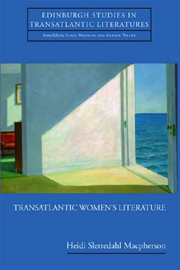Book contents
- Frontmatter
- Contents
- Acknowledgements
- Introduction: ‘No Region for Tourists and Women’
- Part 1: The Exoticised Other
- Part 2: Memoirs and Transatlantic Travel
- Introduction
- 3 ‘There is No World Outside the Text’: Transatlantic Slippage in Eva Hoffman's Lost in Translation
- 4 The Anti-Tourist: Jenny Diski's Skating to Antarctica and Stranger on a Train: Daydreaming and Smoking around America with Interruptions
- Part 3: Negotiating the Foreign/Re-Inventing Home
- Conclusion
- Bibliography
- Index
Introduction
from Part 2: Memoirs and Transatlantic Travel
Published online by Cambridge University Press: 12 September 2012
- Frontmatter
- Contents
- Acknowledgements
- Introduction: ‘No Region for Tourists and Women’
- Part 1: The Exoticised Other
- Part 2: Memoirs and Transatlantic Travel
- Introduction
- 3 ‘There is No World Outside the Text’: Transatlantic Slippage in Eva Hoffman's Lost in Translation
- 4 The Anti-Tourist: Jenny Diski's Skating to Antarctica and Stranger on a Train: Daydreaming and Smoking around America with Interruptions
- Part 3: Negotiating the Foreign/Re-Inventing Home
- Conclusion
- Bibliography
- Index
Summary
Trinh T. Minh-ha argues that ‘travelling perpetuates a discontinuous state of being, [but] it also satisfies, despite the existential difficulties it entails, one's insatiable need for detours and displacements in postmodern culture.’ To travel is to invent not only the destination, but also the traveller, as identity becomes a performance which tailors itself to whatever audience it encounters. The performance of travelling gender has already been introduced, but in the two chapters that follow, this performance moves into other arenas, and specifically into memoir. If late twentieth- and early twenty-first-century women travellers are (on the whole) less concerned with their appearance as manifested through dress and clothing, they are nevertheless still cognisant of their roles as travelling women, and of how gender as well as other social markers influence the way they are received. In what follows, I will explore two very different memoirs of travel: one focused on a reluctant and resistant immigrant, and one on a resistant tourist, who denies her position as tourist even as she inhabits it.
Although there may not, at first, seem to be a lot of connection between the exile's nostalgia for the past and the tourist's present tense focus on elsewhere, in fact, there does seem to be a connection worth probing further. As Dean MacCannell argues, despite the tourist's desire for non-routine activities on holiday, the fact is that they ‘often do see routine aspects of life as it is really lived in the places they visit, although few tourists express much interest in this’.
- Type
- Chapter
- Information
- Transatlantic Women's Literature , pp. 81 - 86Publisher: Edinburgh University PressPrint publication year: 2008

